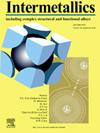Effect of heat treatment on interfacial microstructure and mechanical properties of the aluminum/steel joints with copper transition layer
IF 4.3
2区 材料科学
Q2 CHEMISTRY, PHYSICAL
引用次数: 0
Abstract
In this study, aluminum/steel joints with a copper transition layer are successfully fabricated using wire-arc directed energy deposition (DED) based on the cold metal transfer (CMT) process. The influence of heat treatment on aluminum/steel joints is investigated, focusing on the evolution mechanisms of interfacial microstructures and the regulation of the mechanical properties. The interfacial compound (IMC) layer at the copper-aluminum interface is predominantly composed of CuAl, Cu9Al4, and CuAl2. The transition layer above the IMC layer is composed of α-Al, CuAl2, Al7Cu2Fe, and Al-Si eutectic phase. As the annealing temperature increases and the holding time prolongs, a substantial number of IMCs are generated within the copper-aluminum interface layer, leading to an augmentation in the interfacial layer thickness and an enhancement in the interfacial hardness. When the heat treatment temperature reaches 480 °C, the interfacial hardness increases to 447 HV0.2, while the tensile strength decreases to 22.2 MPa. Conversely, with a solution temperature of 180 °C for 1 h, the tensile strength reaches 74.3 MPa, marking a 39 % improvement over the untreated aluminum/steel joint. The results provide guidance for the fabrication of aluminum/steel joints.
求助全文
约1分钟内获得全文
求助全文
来源期刊

Intermetallics
工程技术-材料科学:综合
CiteScore
7.80
自引率
9.10%
发文量
291
审稿时长
37 days
期刊介绍:
This journal is a platform for publishing innovative research and overviews for advancing our understanding of the structure, property, and functionality of complex metallic alloys, including intermetallics, metallic glasses, and high entropy alloys.
The journal reports the science and engineering of metallic materials in the following aspects:
Theories and experiments which address the relationship between property and structure in all length scales.
Physical modeling and numerical simulations which provide a comprehensive understanding of experimental observations.
Stimulated methodologies to characterize the structure and chemistry of materials that correlate the properties.
Technological applications resulting from the understanding of property-structure relationship in materials.
Novel and cutting-edge results warranting rapid communication.
The journal also publishes special issues on selected topics and overviews by invitation only.
 求助内容:
求助内容: 应助结果提醒方式:
应助结果提醒方式:


